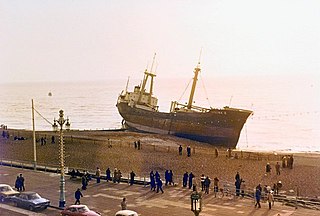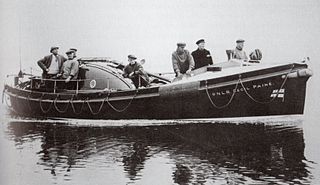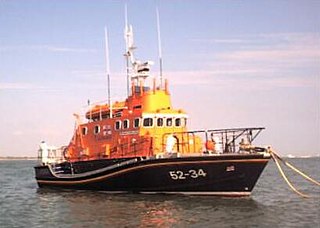RNLB Emma Constance (ON 693)
 |
|---|
| Date | Casualty | Wind/weather | Lives lost | Lives saved | Details |
|---|
| 1927 |
| 27 July | Venetia | Heavy seas, moderate gale | | | Stood down when vessel towed to port by tug |
| 6 September | Ben Torc | Moderate south-easterly breeze, moderate seas | | 6 | Casualty stranded off Gregness, took off six men |
| 1928 |
| 26/27 February | Isle of White | Medium south-south-west breeze, moderate seas | | | Casualty stranded off Belhelvie Beach, rescued by Newburgh lifeboat |
| 18 March | Agnes H Weatherly | South-south-west breeze | | | Casualty stranded 1 mile from Donmouth, no assistance required |
| 6 June | Regain | Strong south-westerly breeze, rough seas | | 8 | Casualty stranded 1 mile off Belhelvie CG station, towed to safety |
| 25 October | HM Drifter Lunar Bow [22] | South westerly fresh breeze, moderate sea | | | Stood by, towed to safety by tug |
| 25 October | HM Drifter Lunar Bow | South westerly fresh breeze, moderate sea | | 2 | Rescued 1 injured naval rating and 1 midshipman |
| 1929 |
| 10 January | Shetland | South-easterly breeze, rough seas | | | 15 ft of water in vessel's hold, flooding taken under control |
| 29 November | Wild Rose | South-easterly strong breeze, rough seas | | | Vessel stranded on rocks, nine rescued from beach |
| 1930|- |
| 22 January | John G Watson | South westerly strong breeze, rough seas | | | Stranded 6½ miles north of Aberdeen, stood by, rescue achieved by No. 2 lifeboat |
| 1931 |
| 7 January | St Merryn | Westerly light breeze, smooth seas | | | Stranded and re-floated without the aid of lifeboat |
| 9 April | Rightway | South westerly moderate breeze, moderate seas | | | Vessel stranded off Collieston CG station, crew rescued by LSA |
| 2 June | Loyal Friend | Northerly moderate breeze, moderate seas | | | Lifeboat stood by following vessel's collision with North Pier |
| 3 December | Nairn | South easterly whole gale, very heavy seas | | | Lifeboat recalled, not required |
| 1932 |
| 14 August | Whitehills lifeboat | Smooth sea | | | Towed broken down lifeboat back to port |
| 1933 |
| 1 January | Trawler Venetia | Southerly strong gale, very heavy seas | 9 | | Vessel stranded 3 miles north of Stonehaven, [23] [24] vessel total loss with all hands |
| 18 January | Ben Screel | Variable light breeze, heavy seas | | | Vessel stranded off Girdleness, lifeboat stood by, crew rescued from shore |
| 19 January | General Birdwood | Northerly moderate breeze, moderate seas | | | Escorted Vessel |
| 4 April | Lifeboat launched to false alarm | | | | Lifeboat recalled after launch |
|
| 3 July | Cretan of Glasgow | Calm and smooth seas | | | Lifeboat not required, vessel towed by pilot tug |
| 20/21 October | Fair Isle | South-easterly fresh breeze, rough seas | | | Vessel with broken rudder, towed by other vessel. lifeboat escorted vessel back to Aberdeen |
| 23/24 October | Granero of Drammen | North-easterly moderate gale, rough seas | | 7 | Vessel stranded at Cawton Ness, crew saved by lifeboat and the LSA |
| 29 December | Strathleven of Aberdeen | South-easterly moderate breeze, very heavy seas | | | Damaged steering gear, towed in by lifeboat, stood by to other vessels |
| 1934 |
| 1 January | Fishing vessels of Gourdon & Stonehaven | | | | Lifeboat on stand-by |
| 20 December | Unknown trawler | Variable light wind, smooth seas | | | Search for vessel, nothing found |
| 1935 |
| 14 February | Local fishing boats | Northerly moderate gale | | | Search of vessels caught in gale, all safe |
| 2 February | Eldorado | South-south-easterly gale, heavy seas | | | Stood by, LSA safely landed crew north of Donmouth |
| 24 June | Balmoral Castle of Aberdeen | Northerly moderate (fog), moderate seas | | | Vessel stranded, refloated on high tide |
| 9 September | Ebor Abbey of Aberdeen | West-south-westerly moderate breeze, moderate seas | | | Lifeboat recalled, rescue by others |
| 5 November | fishing vessels Procure & Quest of Banff | South-south-easterly moderate breeze, heavy seas | | | Escorted back to port |
| 25 December | George Stroud of Aberdeen | South-easterly strong breeze, heavy seas | 3 | 1 | Grounded against North Pier, 1 taken off vessel by lifeboat, 1 taken off by LSA |
| 31 December | Strathairlie of Aberdeen | Light variable winds, slight swell | | | Vessel with broken rudder, lifeboat stood by |
| 1936 |
| 17 January | WM Porter Aberdeen pilot cutter | East-north-easterly fresh breeze, rough seas | | 3 | Pilots fouled rudder on the wreck of George Stroud. Three taken off by lifeboat |
| 21 January | Local fishing boats | East-south-easterly moderate gale, rough seas | | | Stood by until vessels safely in port |
| 6 February | Pretoria of Aberdeen | South-westerly moderate gale, rough seas | | | vessel involved in collision, lifeboat assistance not required |
| 23 February | Ocean Gift of Banff | East-south-easterly strong gale, very heavy seas | | | Adrift in harbour, lifeboat crew mustered but no launch |
| 16 December | Margaret & Frances of Cockenzie | South-south-westerly strong gale, very heavy seas | 2 | | Vessel stranded off Belhelvie CG station, vessel found but a total loss |
| 1937 |
| 21/22 January | Strathebrie of Aberdeen | South-easterly strong gale, very heavy seas | | | Vessel taken into tow |
| 23 January | Utility of Aberdeen | South-easterly strong gale, strong flood | | | vessel hung on stern moorings, vessel towed to fishmarket |
| 26 January | Fairy of Kings Lynn | South-easterly gale, very heavy seas | | 7 | See description Service and rescues section |
| 16 April | Paul Rykens of Aberdeen | Calm, dense fog | | | Vessel stranded, re-floated under own power |
| RNLB J & W (ON 722), Relief (Watson-class) |
| 30 December | Calvinia of Aberdeen | North-north-westerly moderate breeze | | | vessel lost prop, search aborted after vessel was towed into Aberdeen by others |
| 1938 |
| 25 August | Carry On | Variable fog banks, slight swell | | | Vessel aground, towed off by lifeboat |
| 4 December | Branch of Montrose | Southerly moderate gale, rough seas | | | Reported in difficulties, search carried out, vessel towed to port by others |
| 1939 |
| 22 January | Unknown vessel reported capsized | East-south-easterly slight breeze, slight seas | | | Search carried out but nothing found |
|
| World War II |
| 15 September | Vessel reported torpedoed | North easterly moderate breeze | | | Launched to scene, recalled, not required |
| 10 October | Solstad of Oslo | South-easterly storm. heavy seas | | | Search carried out, vessel towed to port by others |
| 31 October | Cairnmona [25] of Newcastle upon Tyne | Easterly light to moderate breeze, rough seas | | | Vessel torpedoed off Rattray Head by U-13 , [26] survivors landed by others |
| 12 December | Cimbria of Copenhagen | | | | Crew mustered only, no launch |
|
| 18 December | Trinity NB [27] of Aberdeen | West-south-westerly, moderate seas | 3 | | Vessel reported bombed, search carried out, no trace found, survivors picked up by Danish schooner Start |
| 1940 |
| 9 January | Gowrie [28] of Dundee | | | | vessel sunk by enemy aircraft four miles east of Stonehaven, crew rescued by others, search carried out for wreckage but nothing found |
| 9 January | Feddy [29] of Copenhagen | South-south-westerly fresh breeze | | 2 | Vessel bombed and on fire, crew members taken off, escorted vessel. |
| 9 January | Ivan Kondrup [29] of Copenhagen | South-south-westerly fresh breeze | 1 | | Vessel bombed. reached port under own steam, one crewman missing |
| 10 January | Feddy [29] of Copenhagen | South-south-westerly light breeze | | | vessel towed into Aberdeen |
| 9 February | Lily of Aberdeen | South-westerly wind, moderate swell | | 3 | Vessel disabled, found by lifeboat and taken into tow |
| 3 March | Unknown bombed vessel reported | North-westerly moderate breeze, slight seas | | | Search carried out but nothing found |
| 18 July | Shipping convoys attacked off Aberdeen on 17 July [30] | | | | Lifeboat and crew on standby at the station |
| 20 October | Conakrain [31] of Freetown | East-south-easterly breeze, rough seas | | | Torpedo damaged in air attack of Girdleness, [32] taken into tow by tug, escorted by lifeboat |
| 21 October | Conakrain [31] of Freetown | | | 2 | Two taken off vessel in Aberdeen bay in heavy weather |
| 23 October | Conakrain [31] of Freetown | Easterly moderate gale, moderate seas | | 23 | Crewmen taken off vessel at request of the Royal Navy |
| 1941 |
| 3 April | Cairnie | East-south-easterly force 7 to 8, very heavy seas | | 7 | Vessel bombed and in distress, Aberdeen harbour entrance, steering damaged and grounded [33] |
| 24 July | Unknown vessel | Calm, smooth seas | | | search carried out, nothing found |
| 8 August | Unknown vessel | | | | lifeboat on stand-by only |
| 2 October | RAF aircraft | Westerly force 4, moderate seas | | | ditched pilot rescued by others, lifeboat recalled |
| 1942 |
| 13 March | Unknown vessel | South-south-westerly force 6, heavy seas | | | No record kept of launch |
| 3 March | HMS Hyderabad and the tug Bruno | Southerly force 3 to 4, smooth seas | | | Both vessels grounded, lifeboat towed of tug, corvette refloated herself |
| 4 April | Bon Accord of Aberdeen | | | | No record kept of the launch |
| 1943 |
| 2 April | Unknown vessel | | | | No record kept of the launch |
| 7 April | Schooner Else of Thisted, Denmark | North force 6 to 9, very rough seas | | | Vessel towed into port with lifeboat escorting |
| 29 November | Trevorian of St Ives | Smooth seas | | | No record kept of the launch |
| 1944 |
| 23 October | Keilehaven of Rotterdam | South-easterly breeze force 3 to 4, growing swells | | 40 | Crew abandoned ship to US ship, but some returned to vessel by lifeboat |
| 1945 |
| 10/11 April | Albert Victor of Vága | Easterly breeze force 3 to 4, breaking surf | | 9 | run aground, lifeboat took off crew and pilot |
| 13 April | Maria of IJmuiden | Light easterly breeze | | | Lifeboat stood by |
| RNLB John Russel (ON 699) Relief (Watson-class) |
| 30 July | May Lily of Peterhead | Slight seas | | | Vessel with engine failure, lifeboat made search, vessel made port under own power |
| 19 October | HM Motor Fishing Vessel 1172 | South-south-easterly breeze force 3 to 5, moderate to rough seas | | 5 | Vessel disabled, towed into Aberdeen by lifeboat |
| 19 December | T L Devlin of Granton | Southerly breeze force 5 to 7 | | | Escorted vessel to port |
| 21 December | Sparkling Star of Peterhead | Light southerly wind, smooth seas | | | Fouled prop, self-cleared, lifeboat stood down |
| 1946 |
| 20 January | Spurs of Grimsby | | | | vessel aground in navigation channel, lifeboat damaged whilst standing by |
| 7 August | Harmonious II of Aberdeen | South-westerly breeze force 2 to 3, light to moderate seas | | 6 | Broken down vessel, towed into port |
| 1947 |
| 20 October | Harvest Gleaner of Buckie | South-south-westerly breeze force 5, moderate seas | | | Towed into port by others, lifeboat stood down |
| 1948 |
| 5 February | Northman of Aberdeen | Southerly breeze force 4 to 6 | | | Both vessel and lifeboat grounded, pulled off by tug |
| 1949 |
| 13 January | Welbeckof Grimsby | South-westerly breeze force 2, smooth to slight seas | | | Lifeboat then tug towed vessel off |
| 23 September | Alirmay of Aberdeen | South-easterly breeze force 3 to 4 | | | Lifeboat recalled, not required |
| 24 September | Brightside | Easterly breeze force 1 to 2, slight seas | | | Stranded vessel, crew landed by others, lifeboat recalled |
| 1950 |
| 19 September | Saga of Aberdeen | South-south-easterly force 8 to 9, very high seas | | | Vessel with engine failure, Aberdeen lifeboat recalled |
| 19 September | Saga of Aberdeen | South-south-easterly force 8 to 9, very high seas | | | Second launch to vessel towed by Peterhead lifeboat, Aberdeen lifeboat escorted |
| 26 September | Lyndburn of Aberdeen | North-easterly force 4, rough seas | | 1 | Vessel grounded, lifeboat takes off 1 |
| 1951 |
| 14 February | Yawl Glen of Aberdeen | South-easterly force 3 to 4, slight seas | | 2 | Vessel broken down, towed into port by lifeboat |













